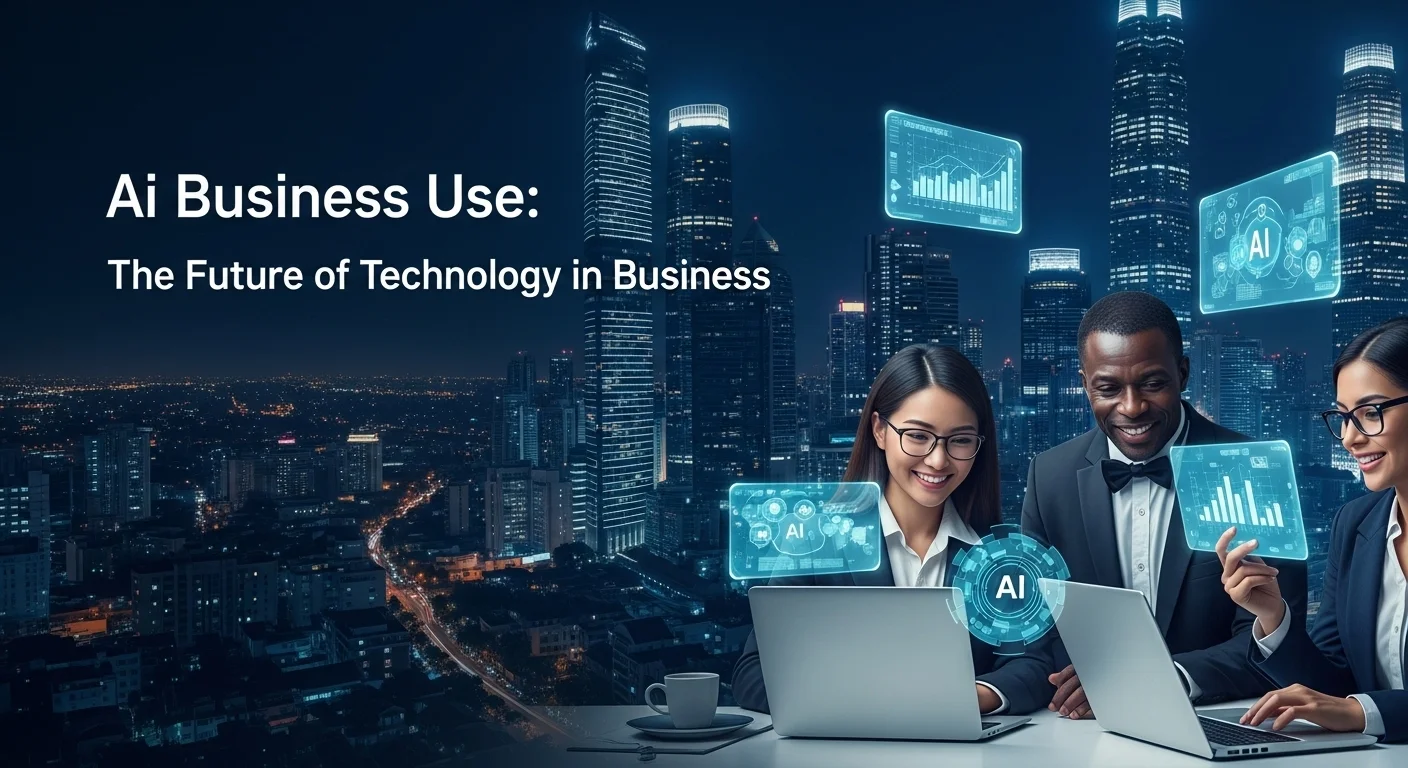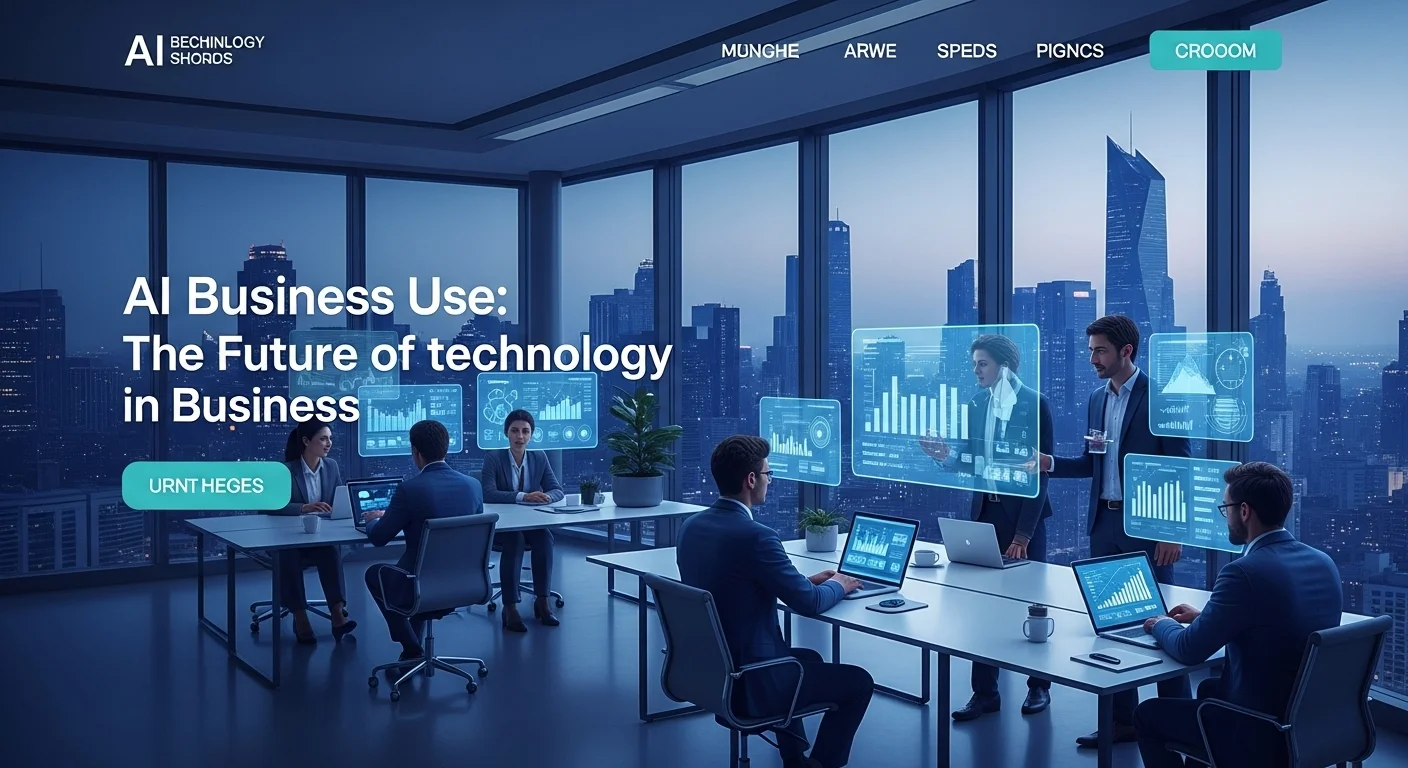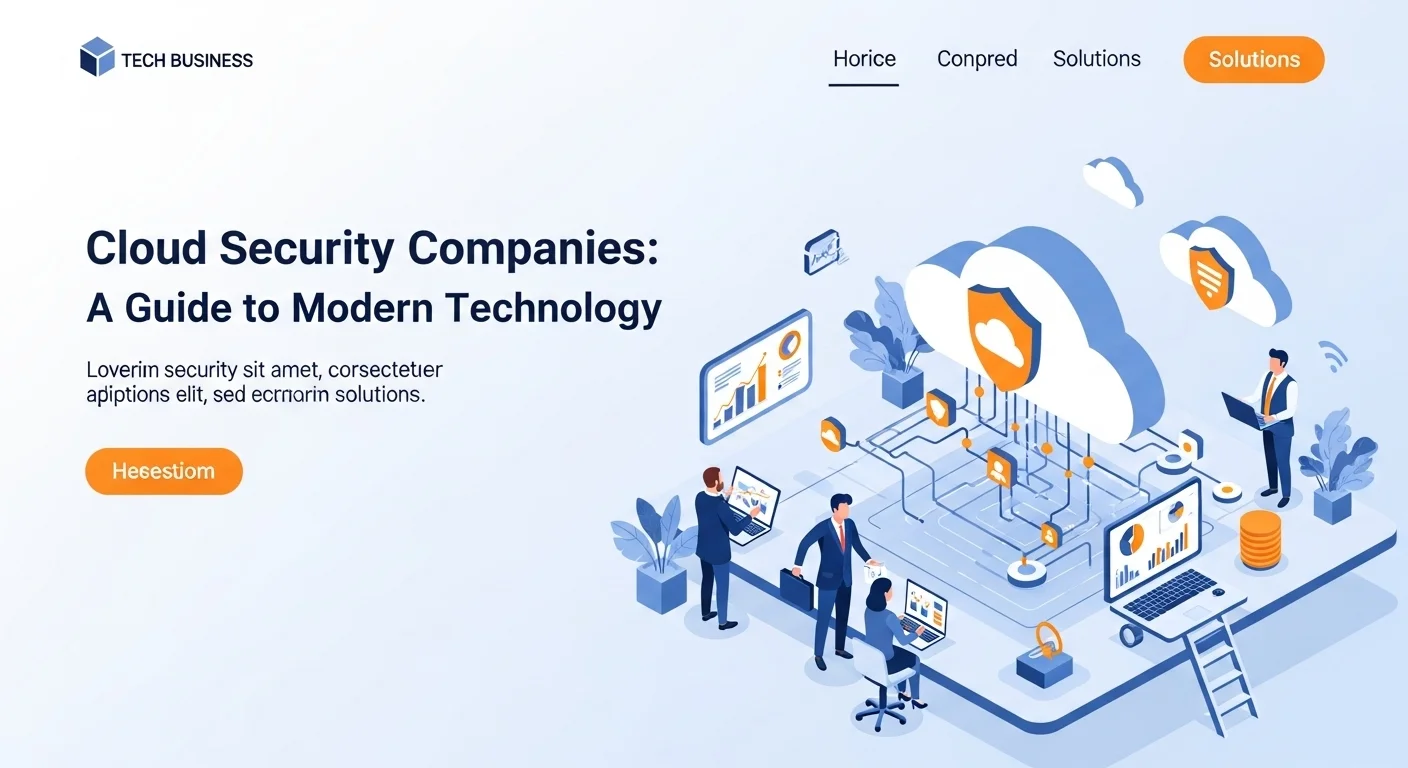Putting AI to Work: A Practical Guide to Using AI in Your Business

Executive Summary
Everywhere you look, people are talking about Artificial Intelligence. But as a business leader, you're probably asking the real question: How do we actually use it? It's easy to get lost in the technical jargon. I've spent years helping companies bridge the gap between AI potential and real-world results, and I can tell you it's less about complex code and more about smart strategy. This article cuts through the noise. We'll walk through what AI truly means for your operations, how to build a practical strategy for implementing it, and the essential tools you can start using today. Forget the futuristic fluff; this is your hands-on guide to making AI a powerful part of your business right now.
Table of Contents
Table of Contents
- What is AI in a Business Context and Why Does It Matter?
- Breaking Down AI: What You Really Need to Know
- The Real-World Impact of Using AI to Boost Operations
- Concrete Benefits of AI You Can See Across Industries
What is AI in a Business Context and Why Does It Matter?
When we talk about using Artificial Intelligence in a business setting, we're not talking about science fiction robots. We're talking about applying smart technologies to solve real problems and reach specific goals. I've seen it firsthand: leveraging AI isn't just a passing trend; it's a massive shift in how companies function and compete. Frankly, understanding how to apply AI is becoming a baseline requirement for staying relevant. It represents a new wave of innovation that's reshaping entire industries, creating new ways of doing business, and unlocking efficiency that we could only dream of a decade ago. For any modern company, getting a handle on AI is no longer optional—it's essential for survival and growth.
Breaking Down AI: What You Really Need to Know
At its heart, AI is about creating computer systems that can perform tasks that normally require human intelligence—things like learning from experience, solving problems, and understanding language. When we put AI to work in a business, we're simply using these capabilities to tackle commercial challenges. This can be as simple as automating data entry or as complex as guiding high-level strategic decisions. Here are the core technologies I see making the biggest waves:
- Machine Learning (ML): Think of this as teaching a computer by showing it examples. You feed it massive amounts of data, and it learns to spot patterns and make predictions. A classic example I love is an e-commerce site using ML to suggest products you might actually want to buy based on what you've looked at before.
- Natural Language Processing (NLP): This is what allows machines to understand and respond in human language. It’s the magic behind the customer service chatbots that don't drive you crazy, tools that analyze customer feedback on social media, and voice assistants like Alexa or Siri.
- Computer Vision: This field teaches computers to see and interpret the world. In business, I’ve seen it used for everything from facial recognition for secure access, to spotting tiny defects on a manufacturing line, to managing store inventory just by analyzing images.
- Robotics and Automation: This is where AI gets physical. AI-driven robots are performing tasks with incredible precision, from assembling phones on a factory floor to zipping around a warehouse to manage stock.
By blending these technologies, businesses can create incredibly sophisticated systems that learn, adapt, and act on their own to help hit company targets.
The Real-World Impact of Using AI to Boost Operations
In today's fast-paced digital world, everyone's looking for an edge. Using AI to improve your business operations is one of the most powerful ways to get one. The strategic power of AI comes from its ability to fundamentally change how work gets done, bringing benefits that ripple across the whole company.
First, AI makes data-driven decision-making a reality, not just a buzzword. Businesses are swimming in data from customers, supply chains, and market trends. AI can digest all of this information in real-time, pulling out critical insights a human team could never spot. This lets leaders make faster, smarter decisions, cutting risk and seizing opportunities. For instance, banks use AI to flag fraudulent transactions in seconds, something I’ve helped implement with incredible success.
Second, using AI in your business brings huge gains in efficiency. By automating the boring, repetitive tasks, you free up your talented employees to focus on creative and strategic work that actually grows the business. This isn’t just about boosting productivity; it’s about reducing costly human errors. From smart workflows to automated reports, AI streamlines everything, cutting costs and speeding up business cycles. It's the ultimate tool for creating a lean, agile operation.
Finally, AI is a massive engine for innovation. It gives you the tools to dream up new products, services, and entirely new ways of doing business. Think about personalized medicine, self-driving cars, or smart home gadgets—AI is at the core of all of them. By tapping into AI, companies can push boundaries and create offerings that are smarter and more tuned-in to customer needs, which is crucial for staying ahead of the curve.
Concrete Benefits of AI You Can See Across Industries
The great thing about AI is that its benefits aren't just theoretical; you can see them making a real difference in businesses everywhere.
- A Better Customer Experience: AI-powered chatbots offer 24/7 support, while personalization engines, like those used by Netflix and Amazon, create experiences that feel tailor-made, boosting loyalty and sales.
- Smarter Sales and Marketing: I've worked with marketing teams who use AI to pinpoint the most promising leads and optimize their ad spend, resulting in higher conversion rates and a much more efficient sales process. It gives you a deep understanding of your customer's journey.
- Optimized Supply Chains: AI can predict demand with stunning accuracy, manage inventory to prevent waste, and find the most efficient shipping routes. This creates a supply chain that's not just cheaper to run but also more resilient to disruptions.
- Next-Level Cybersecurity: As cyber threats get sneakier, AI has become our best defense. AI security systems can spot unusual activity and neutralize threats before they cause damage, which is essential for protecting your business and customer data.
- Revolutionizing Healthcare: In the medical world, AI is helping doctors analyze scans with more accuracy than the human eye, predict disease outbreaks, and even discover new drugs. It’s paving the way for truly personalized medicine.
- Transforming Finance: Banks are using AI for everything from algorithmic trading and fraud detection to assessing credit risk. It helps them automate compliance and offer personalized financial advice at scale.
To put it simply, the potential for AI in business is enormous. It’s a game-changing technology that enables smarter decisions, incredible efficiency, and constant innovation. The question for leaders today isn't *if* they should adopt AI, but *how* they can strategically weave it into their operations to unlock its true power.

A Complete Guide to Implementing AI in Your Business
Successfully bringing artificial intelligence into your business is more than just buying the latest software. From my experience, it's a journey that requires a clear strategy, a solid grasp of the technology, and the right resources. This guide breaks down what it really takes to implement AI effectively, turning its potential into real-world business solutions. We'll cover everything from building your AI roadmap to picking the right tools and measuring what matters.
Developing a Strategic Framework for AI Implementation
Before you even think about algorithms, a successful AI initiative starts with a strong strategy. This plan has to be directly tied to your company's main goals. Otherwise, you risk ending up with cool tech projects that don't actually move the needle for the business.
1. Pinpoint Your Problems and Opportunities: The first step is always to look at your business and ask, 'Where can AI make the biggest difference?' I always advise clients to conduct a thorough review of their current processes. Where are the bottlenecks? What tedious tasks are eating up valuable time? Is there a mountain of data you're not using? Focusing on solving a specific, high-impact problem ensures your AI efforts are targeted and meaningful.
2. Set Clear Goals and Metrics (KPIs): Once you have a use case, define what success looks like in plain numbers. Is it reducing operational costs by 20%? Increasing customer retention by 15%? You need to establish these Key Performance Indicators (KPIs) from day one to track your progress and measure the return on investment (ROI).
3. Check Your Data Readiness: Data is the fuel for AI. Without clean, relevant, and accessible data, even the smartest algorithm is useless. A critical early step is a 'data audit.' Take stock of the data you have, where it is, and what shape it's in. You might need to invest in cleaning up your data or improving your data storage before you can effectively put AI to work.
4. Start Small, Then Scale: I'm a big believer in starting with a pilot project. It lets you test the technology, learn valuable lessons, and show real results to get everyone on board without a huge initial investment. A successful pilot builds the momentum you need for larger projects. Your strategy should include a clear plan for how you'll scale up what works across the rest of the organization.
Technical Methods and Business Techniques for Success
With your strategy set, it's time to get into the 'how.' This involves a mix of data science, solid engineering, and good old-fashioned change management.
Technical Methods:
- Choosing the Right Algorithms: The AI model you use depends entirely on the problem. For sorting things into categories (like spam vs. not spam), you might use one type of algorithm. For predicting future trends (like next quarter's sales), you'd use another. For really complex tasks like understanding images or text, you'll likely turn to deep learning and neural networks.
- Training and Validating Your Model: You 'teach' an AI model by feeding it data. It adjusts itself to make fewer mistakes over time. But the most important step is testing it on data it has never seen before. This validation step ensures your model will actually work in the real world and wasn't just 'memorizing' the training data.
- Deployment and Maintenance (MLOps): A trained model is useless until it's integrated into your business workflows. This is where MLOps (Machine Learning Operations) comes in. It's the set of practices for launching, monitoring, and maintaining your AI models in a live environment to ensure they keep working reliably.
Business Techniques:
- Build an AI-Ready Culture: Technology is only half the battle. Your entire organization, from the top down, needs to embrace the change. This means communicating the vision, educating employees on how AI will help them, and addressing fears about jobs. I've found that creating a culture of learning and experimentation is key to long-term success.
- Manage the Change: Implementing AI will change how people work. You need a structured plan to manage that transition. Involve employees in the process, provide great training, and keep communication lines open to handle concerns and get feedback.
- Measure Your ROI: To keep the investment flowing, you have to prove that AI is delivering value. Continuously track those KPIs you set at the beginning—cost savings, revenue growth, productivity increases—to build a powerful case for how AI is improving your business operations.
Available Resources: Platforms, Tools, and the Cloud
The good news is, getting started with AI is easier than ever thanks to the incredible resources available, especially from cloud providers. You don't have to build everything from scratch anymore.
- Cloud AI Platforms: Services like Google Cloud AI, AWS AI, and Microsoft Azure AI offer a full suite of tools to build and manage AI. They have everything from pre-trained models for common tasks to powerful platforms like Amazon SageMaker for developing your own custom solutions.
- Open-Source Libraries: The AI world is built on open-source tools. Libraries like TensorFlow, PyTorch, and scikit-learn are the industry standards and give you powerful, flexible, and free tools to build with.
- The Power of the Cloud: Cloud computing has been the great equalizer for AI. Training complex models takes a massive amount of computing power. The cloud gives you on-demand access to this power, so you only pay for what you use. This scalability makes AI accessible to businesses of all sizes, not just tech giants.
By using these resources, companies can speed up development, cut costs, and focus on what they do best: applying AI to solve their unique challenges. It’s a holistic process, blending smart strategy with solid execution and a culture that's ready for the future.

Tips and Strategies to Get the Most from AI in Your Business
As your business moves from just trying out AI to making it a core part of your operations, the game changes. It's no longer about *if* you have AI, but how well you use it. The goal is to use it effectively and ethically to create a better experience for both your team and your customers. Here are some practical tips and strategies I've learned for refining your AI use, focusing on best practices, essential tools, and the crucial link between AI, security, and ethics.
Best Practices for Sustainable and Responsible AI
For AI to be a long-term asset, it has to be managed responsibly. This means building a framework that ensures your AI is fair, transparent, and always improving. For any company serious about using AI ethically, these practices are non-negotiable.
1. Make Data Privacy and Security Your Top Priority: AI systems often handle incredibly sensitive data, from customer details to company secrets. You absolutely must have rock-solid security and data governance in place. This means complying with regulations like GDPR, keeping data anonymous whenever possible, and strictly controlling who has access. A single data breach in an AI system can destroy customer trust and lead to massive legal trouble.
2. Commit to Ethical AI and Transparency: Sometimes, complex AI models can feel like a 'black box,' making decisions for reasons that are hard to understand. This can lead to biased or unfair results. A best practice is to strive for 'explainable AI' (XAI), where you can actually audit and understand the model's logic. It's also vital to regularly check your models for biases related to race, gender, or other factors. I often recommend clients establish an ethics committee to ensure their AI aligns with their company's values.
3. Foster Human-AI Collaboration, Not Replacement: In my experience, the most powerful use of AI is to augment human abilities, not replace them. Position AI as a partner that frees your employees from repetitive work and gives them the insights they need to make smarter decisions. This creates a collaborative environment where human expertise and AI's processing power work together. This means you have to invest in training your team so they're comfortable working alongside these new smart systems.
4. Continuously Monitor and Improve: An AI model isn't something you can set and forget. Its performance can slip over time as real-world data changes—a problem we call 'model drift.' It's crucial to constantly monitor your AI's performance against your goals. Create a feedback loop where models are regularly retrained with fresh data to keep them sharp and relevant. This cycle of improvement is a true sign of a mature AI strategy.
Essential Business Tools and Tech Experiences
The market is full of fantastic AI-powered tools that can streamline just about any business function. Using them can give you a real edge and improve everyone's tech experience.
- Customer Relationship Management (CRM): AI-driven CRMs like Salesforce Einstein can analyze customer interactions to predict which deals are likely to close and even automate follow-up emails, making your sales team far more effective.
- Marketing Automation: Platforms like HubSpot use AI to personalize marketing campaigns for thousands of customers at once, score leads, and optimize your ad budget to get the best results.
- Business Intelligence (BI) and Analytics: Tools like Tableau and Power BI are embedding AI features that let you ask questions about your data in plain English and automatically uncover insights you might have missed.
- Cybersecurity Solutions: AI is a game-changer for security. Companies like Darktrace use machine learning to spot and respond to threats in real-time by identifying strange behavior that older systems would miss. This is a perfect example of using AI to protect your business.
- Productivity and Collaboration: Even tools you use every day are getting smarter. Microsoft 365 Copilot and Google Workspace's AI can summarize long email chains, help draft documents, and analyze data in spreadsheets, giving a huge productivity boost to your team.
For more on integrating these technologies, a great resource is Forbes' guide on AI integration. This valuable external article offers a structured approach for business leaders looking to operationalize AI effectively.
The Future Outlook: AI, the Cloud, and Cybersecurity
The future of AI in business is completely tied to advances in cloud computing and cybersecurity. The cloud provides the massive, on-demand power needed to run sophisticated AI, making it accessible to nearly everyone. As we look ahead, the bond between AI and the cloud will only get stronger, with more powerful AI services offered directly by cloud providers.
At the same time, as our reliance on AI grows, cybersecurity becomes more critical than ever. The same AI that helps our businesses can also be used by attackers. The future is an arms race between AI-powered attacks and AI-powered defenses. Smart businesses will invest heavily in a cybersecurity strategy that uses AI to protect all their digital assets, from the cloud down to every last laptop.
In the end, enhancing your business with AI is about more than just technology. It demands a commitment to ethics, smart adoption of powerful tools, and a clear-eyed view of how AI, the cloud, and cybersecurity all fit together. By following these strategies, you can build a more resilient, intelligent, and competitive business for the future.
Expert Reviews & Testimonials
Sarah Johnson, Business Owner ⭐⭐⭐⭐
A solid overview. As a small business owner, I was hoping for a few more budget-friendly starting points, but it definitely got me thinking about a real strategy. Very helpful!
Mike Chen, IT Consultant ⭐⭐⭐⭐
This is a great starting point for consultants like me. It connects the tech to the business goals, which is key. I'd love a future article diving even deeper into the MLOps side.
Emma Davis, Tech Expert ⭐⭐⭐⭐⭐
Finally, an article that cuts through the hype! This is a comprehensive, no-nonsense guide to implementing AI. I'm sharing this with my entire team. Perfectly explained.



